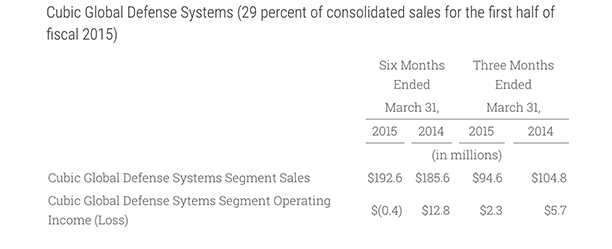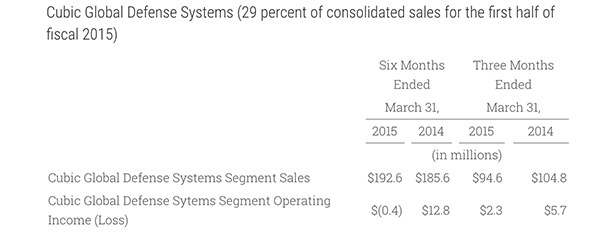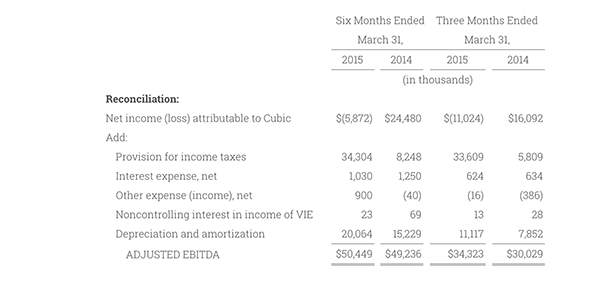- Sales of $338.8 million for the quarter and $657.3 million for the six-month period
- Adjusted EBITDA1 of $34.3 million for the quarter and $50.4 million for the six-month period
- Net loss of $11.0 million, or $0.41 per diluted share for the quarter and a net loss of $5.9 million, or $0.22 per diluted share for the six-month period, which included the impact of a non-cash valuation allowance on deferred tax assets of $29.3 million or $1.09 per diluted share
- Total backlog of $3.102 billion as of March 31, 2015
- Cash provided by operating activities of $52.8 million for the quarter and $61.1 million for the six-month period
- Revenue guidance maintained; EPS guidance lowered to a range of $1.10 to $1.30 per share
SAN DIEGO, Calif. - May 18, 2015 – Cubic Corporation (NYSE: CUB) today reported its financial results for the quarter and six months ended March 31, 2015.
Results for Six Months Ended March 31, 2015
Sales for the first six months of fiscal 2015 were $657.3 million compared to $661.6 million in fiscal 2014, a slight decrease of 1 percent. Sales from recent acquisitions for the first half of fiscal 2015 were $40.8 million compared to $18.1 million last year. Foreign currency translation reduced reported sales by $18.0 million, or 3 percent year-to-date.
Operating income was $30.4 million in the first six months of 2015 compared to $34.0 million in 2014, a decrease of 11 percent. Operating income was impacted by a restructuring charge in the second quarter of 2015 totaling $5.4 million, costs related to an audit committee investigation totaling $2.5 million, and operating losses on recently acquired businesses totaling $6.2 million. Foreign exchange translation further reduced operating income by $3.1 million.
Adjusted EBITDA 1 increased 2 percent to $50.4 million or 7.7 percent of sales for the first six months of fiscal 2015 compared to $49.2 million or 7.4 percent of sales in fiscal 2014.
Net loss attributable to Cubic shareholders was $5.9 million, or a loss of $0.22 per diluted share, compared to net income attributable to Cubic of $24.5 million, or $0.91 per diluted share, in the first six months of fiscal 2014. The net loss resulted from a non-cash tax charge of $29.3 million related to establishing a valuation allowance against the company’s net U.S. deferred tax assets and the additional costs and charges described above.
Total backlog was $3.102 billion at the end of the quarter compared to $3.180 billion at September 30, 2014, a decrease of $78.3 million. Decreases in backlog for CTS and CGD Services were partially offset by an increase in CGD Systems. Changes in currency exchange rates between September 30, 2014 and March 31, 2015 reduced backlog by $120.6 million.
“Our underlying business fundamentals remain strong, and we are taking important actions across the board to improve the company’s operating efficiency,” said Bradley H. Feldmann, president and chief executive officer of Cubic Corporation. “We are encouraged by the positive trends we see in our business segments and are focused on the continued advancement of our OneCubic Strategy, including the implementation of a new ERP system to provide a scalable platform as we grow. Primarily as a consequence of the deferred tax valuation allowance and the impact of foreign currency exchange rates on our expected financial results, we are revising our EPS guidance for fiscal year 2015.”
(1)Adjusted EBITDA is a Non-GAAP metric - see the table included in the section titled “Use of Non-GAAP Financial Information” for a reconciliation of these GAAP and non-GAAP financial measures)

CTS sales increased 1 percent for the six-month period to $278.2 million from $276.1 million last year. Sales from ITMS, a company acquired in December 2013, contributed sales of $22.2 million during the six months ended March 31, 2015, compared to $17.3 million last year. Revenue recognized on a system development and operation contract in Chicago was higher in the first half of fiscal 2015 than the first six months of last year. CTS also recognized higher sales on a services contract in Australia. These increases in sales were partially offset by decreased work on system development contracts in the U.K. and U.S. In addition, changes in foreign currency exchange rates compared to last year reduced revenue by $14.8 million for the first half of 2015.
CTS operating income increased 96 percent for the first half of fiscal 2015 to $39.1 million from $19.9 million last year. The increase was attributable to an increase in gross margins on the contract in Chicago described above and a commercial settlement totaling $3.6 million. These increases in operating income were partially offset by cost growth on a system development contract in North America which reduced operating income by $7.6 million and the impact of changes in foreign currency exchange rates compared to last year which reduced operating income by $2.4 million.

CGD Services sales decreased 7 percent for the first half of fiscal 2015 to $186.5 million compared to $199.9 million last year. Sales for the first half were lower primarily because there were fewer training exercises conducted under a contract with the Joint Readiness Training Center and a general reduction in the number of training exercises and other support requirements for our U.S. government customers. These reductions were partially offset by growth in the simulator training business.
CGD Services operating income decreased 74 percent for the six-month period ended March 31, 2015 to $1.1 million from $4.2 million last year. The lower operating income for the period resulted from the decreased sales described above, including the number of training exercises supported and reduced profit margins on contracts due to competitive pressures driving down bid prices.

CGD Systems sales increased 4 percent for the first half of fiscal 2015 to $192.6 million from $185.6 million last year. Businesses recently acquired by CGD Systems contributed sales of $18.6 million in the first half of fiscal 2015 compared to $0.8 million last year. Sales were higher from air combat training systems, but were lower from datalinks, ground combat training systems and engagement skills trainers.
CGD Systems had an operating loss of $0.4 million for the first half of fiscal 2015 compared to operating income of $12.8 million last year. The decrease in operating income for the first half of fiscal 2015 was primarily driven by a restructuring charge of $4.1 million in the second quarter of 2015 and increased development costs for a training system which resulted in a decrease in operating income of $5.1 million. In addition, lower operating income on lower sales of ground combat training systems and engagement skills trainers contributed to the decrease. These decreases were partially offset by higher operating income from higher sales of air combat training systems. Businesses recently acquired by CGD Systems had operating losses of $5.0 million for the first half of fiscal 2015 compared to $3.4 million last year.
Cash Flows
Operating activities provided cash of $61.1 million. All three segments contributed to cash provided by operating activities for the first half of fiscal 2015. We invested $89.5 million to acquire DTECH LABs in the first half of 2015. A portion of this purchase was funded by draws on our U.S. revolving credit facility. At March 31, 2015 we had $55 million outstanding under this facility at a variable interest rate of 1.64 percent.
Audit Committee Investigation
The audit committee of the Board of Directors has conducted an investigation with the assistance of Latham & Watkins LLP and Deloitte FAS LLP to review the company’s controls and procedures in connection with programs that are accounted for under the percentage of completion method. Through the application of the company’s internal controls, management identified an issue which led to the investigation. As a result of the investigation, the audit committee and management of the company have together determined that, as of September 30, 2014, the total estimated costs of certain of our CGD Systems segment (formerly known as Cubic Defense Systems (CDS) segment) contracts were inappropriately reduced during its accounting close for the year ended September 30, 2014. The inappropriate reduction of the estimated costs to complete these contracts resulted in the overstatement of CGD Systems sales and operating income by approximately $750,000 for the fourth quarter and full year of fiscal 2014. This error, as well as the unrelated errors described in the following paragraph, are cumulatively and individually considered immaterial to the 2014 financial statements and are immaterial to the expected full year results for 2015 and had no effect on the trend of financial results. As such, these errors have been corrected in the financial statements for the quarter ended December 31, 2014.
Correction of Immaterial Errors
During the accounting close for our March 31, 2015 financial statements, management of the company identified certain errors in the September 30, 2014 financial statements including an overstatement of revenue recognition on one contract and the understatement of cost of sales on a small number of contracts. The cumulative impact of these errors resulted in an overstatement of the company’s operating income for the year ended September 30, 2014 of $1.6 million. These errors, as well as the unrelated errors described above related to the audit committee Investigation, are cumulatively and individually considered immaterial to the 2014 financial statements and are immaterial to the expected full year results for 2015 and had no effect on the trend of financial results. As such, these errors have been corrected in the financial statements for the quarter ended December 31, 2014.
Conference Call
Cubic management will host a conference call to discuss the company’s second quarter and six month results today, Monday, May 18, 2015, at 4:30 PM ET (1:30 PM PT) that will be simultaneously broadcast over the Internet. Bradley H. Feldmann, president and chief executive officer and John “Jay” D. Thomas, executive vice president and chief financial officer, will host the call.
Conference Dial-In Information
Financial analysts and institutional investors interested in participating in the call are invited to dial
- (877) 407-8293 for domestic callers
- (201) 689-8349 for international callers.
Please dial-in approximately 10 minutes prior to the start of the call.
Audio Webcast
Listeners may access the conference call live over the Internet at the company’s website under the “Investor Relations” tab at www.cubic.com.
Please allow 15 minutes prior to the call to visit our website to download any necessary audio software. For those unable to listen to the live broadcast, an archived version will be available at the same location for approximately 30 days following the live webcast.
About Cubic
Cubic Corporation is globally diversified in transportation and defense markets. The company’s Transportation segment is a leading systems integrator that develops and provides fare collection infrastructure, services and technology for public transit authorities and operators worldwide. CGD Services is a leading provider of training, operations, maintenance, technical and other support services to the U.S. and allied nations. The CDG is a leading provider of realistic combat training systems and secure communications systems. For more information about Cubic, see the company’s web site at www.cubic.com.
Forward-Looking Statements
This press release contains forward-looking statements within the meaning of the Private Securities Litigation Reform Act of 1995 that are subject to the safe harbor created by such Act. Forward-looking statements include, among others, statements about our expectations regarding future events or our future financial and/or operating performance. These statements are often, but not always, made through the use of words or phrases such as “may,” “will,” “anticipate,” “estimate,” “plan,” “project,” “continuing,” “ongoing,” “expect,” “believe,” “intend,” “predict,” “potential,” “opportunity” and similar words or phrases or the negatives of these words or phrases. These statements involve risks, estimates, assumptions and uncertainties that could cause actual results to differ materially from those expressed in these statements, including, among others: our dependence on U.S. and foreign government contracts; delays in approving U.S. and foreign government budgets and cuts in U.S. and foreign government defense expenditures; the ability of certain government agencies to unilaterally terminate or modify our contracts with them; our ability to successfully integrate new companies into our business and to properly assess the effects of such integration on our financial condition; the U.S. government’s increased emphasis on awarding contracts to small businesses, and our ability to retain existing contracts or win new contracts under competitive bidding processes; the effects of politics and economic conditions on negotiations and business dealings in the various countries in which we do business or intend to do business; risks associated with the restatement of our prior consolidated financial statements, including our identification of material weaknesses in our internal control over financial reporting; competition and technology changes in the defense and transportation industries; our ability to accurately estimate the time and resources necessary to satisfy obligations under our contracts; the effect of adverse regulatory changes on our ability to sell products and services; our ability to identify, attract and retain qualified employees; business disruptions due to cyber security threats, physical threats, terrorist acts, acts of nature and public health crises; our involvement in litigation, including litigation related to patents, proprietary rights and employee misconduct; our reliance on subcontractors and on a limited number of third parties to manufacture and supply our products; our ability to comply with our development contracts and to successfully develop, introduce and sell new products, systems and services in current and future markets; defects in, or a lack of adequate coverage by insurance or indemnity for, our products and systems; and changes in U.S. and foreign tax laws, exchange rates or our economic assumptions regarding our pension plans. In addition, please refer to the risk factors contained in our SEC filings available at www.sec.gov, including our most recent Annual Report on Form 10-K and Quarterly Reports on Form 10-Q. Because the risks, estimates, assumptions and uncertainties referred to above could cause actual results or outcomes to differ materially from those expressed in any forward-looking statements, you should not place undue reliance on any forward- looking statements. Any forward-looking statement speaks only as of the date hereof, and, except as required by law, we undertake no obligation to update any forward-looking statement to reflect events or circumstances after the date hereof.
Use of Non-GAAP Financial Information
Adjusted EBITDA represents net income attributable to Cubic before interest, taxes, non-operating income, goodwill impairment charges, depreciation and amortization. We believe that the presentation of Adjusted EBITDA included in this report provides useful information to investors with which to analyze our operating trends and performance and ability to service and incur debt. Also, Adjusted EBITDA is a factor we use in measuring our performance and compensating certain of our executives. Further, we believe Adjusted EBITDA facilitates company-to-company operating performance comparisons by backing out potential differences caused by variations in capital structures (affecting net interest expense), taxation, the age and book depreciation of property, plant and equipment (affecting relative depreciation expense), goodwill impairment charges and non-operating expenses which may vary for different companies for reasons unrelated to operating performance. In addition, we believe that Adjusted EBITDA is frequently used by securities analysts, investors and other interested parties in their evaluation of companies, many of which present an Adjusted EBITDA measure when reporting their results. Adjusted EBITDA is not a measurement of financial performance under GAAP and should not be considered as an alternative to net income as a measure of performance. In addition, other companies may define Adjusted EBITDA differently and, as a result, our measure of Adjusted EBITDA may not be directly comparable to Adjusted EBITDA of other companies. Furthermore, Adjusted EBITDA has limitations as an analytical tool, and you should not consider it in isolation, or as a substitute for analysis of our results as reported under GAAP.
Because of these limitations, Adjusted EBITDA should not be considered as a measure of discretionary cash available to us to invest in the growth of our business. We compensate for these limitations by relying primarily on our GAAP results and using Adjusted EBITDA only supplementally. You are cautioned not to place undue reliance on Adjusted EBITDA.
The following table reconciles Adjusted EBITDA to net income attributable to Cubic, which we consider to be the most directly comparable GAAP financial measure to Adjusted EBITDA.
